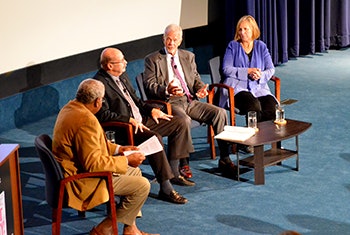 From left: Frank Bond, Det. Tom Lange (ret.), Rock Harmon and Dr. Jenifer Smith (Photo: NLEOMF)
From left: Frank Bond, Det. Tom Lange (ret.), Rock Harmon and Dr. Jenifer Smith (Photo: NLEOMF)
On Tuesday, October 4, 2016, the National Law Enforcement Museum presented the 14th installment of its popular Witness to History panel discussion series, sponsored by Target. "Investigating O.J. Simpson: The Case for DNA" was held at the U.S. Navy Memorial's Burke Theatre. Guests enjoyed a discussion with Det. Tom Lange (Ret.), Los Angeles (CA) Police Department , one of the lead detectives on the Simpson investigation; Mr. Rock Harmon, a former Senior Deputy District Attorney in Alameda County, CA, and a DNA expert for the O.J. Simpson prosecution team; and Dr. Jenifer Smith, director of the District of Columbia's Department of Forensic Science.
DNA evidence was key to the investigation of the 1994 murders of Ronald Goldman and Nicole Brown Simpson, and it was the job of LAPD Detectives Phil Vannatter and Tom Lange to solve the case. Simpson's ex-husband, famed football player and Hollywood personality O.J. Simpson, was a prime suspect. Thus began one of the most infamous cases in American history, culminating in the trial of the century.
National Law Enforcement Officers Memorial Fund President and CEO Craig W. Floyd kicked off the event by welcoming about 110 guests in attendance. After a brief introduction, Mr. Floyd introduced moderator Frank Bond, a retired anchor and reporter of Washington DC's WUSA-TV, and current documentary producer for the Newseum.
Tom Lange's connection to the O.J. Simpson investigation began when his phone rang at 3 a.m. and he was told to report to a murder scene. From there he led a rapt audience through the first hours of the investigation and the methodical processing of the crime scenes. He described the type of professional demeanor required to process the scene. Lange said, "It may sound cold, but you have to look at these bodies as evidence…they are protected like everything else at the scene."
Dr. Jenifer Smith talked about the significance of DNA evidence and the importance of being able to explain that evidence to a jury. She said of this case, "The DNA was compelling evidence, but it may not have been presented well (in court)." She shared how she used examples of court footage from the Simpson case in the classroom to teach students how important it is for forensic scientists to not only use good science, but to be able to explain it.
When asked about the glove found at the crime scene, Rock Harmon replied that it was presented by the defense attorneys as though it was planted by the LAPD. Lange explained that this simply was not true and that in essence "the LAPD was on trial." Both Harmon and Lange talked about how having cameras in the courtroom 24/7 and the overall length of the trial was unusual and did not work in the prosecution's favor. The defense was able to build and present a compelling narrative that was not based on evidence.
One highlight of the evening came during the question and answer portion when Lange was asked about his role in getting O.J. Simpson to safety during the infamous chase in the white Bronco. A suspect at this point, Simpson had a gun and was threatening to kill himself. The chase went live on TV and Lange thought it was wrong that no one was seriously attempting to stop Simpson. He said, "Then I realized, wait a minute, I've got his phone number…so I called it, and we talked for about 25 minutes." Lange explained how important it was to just keep Simpson's mind occupied on the phone in order to get him home safely.
The Museum's Witness to History program began in June 2011. Since the inaugural event, 13 more have been presented. Video recordings and photos from the events are available to view on the Museum's website.
For more information about the National Law Enforcement Museum, visit www.LawEnforcementMuseum.org.









